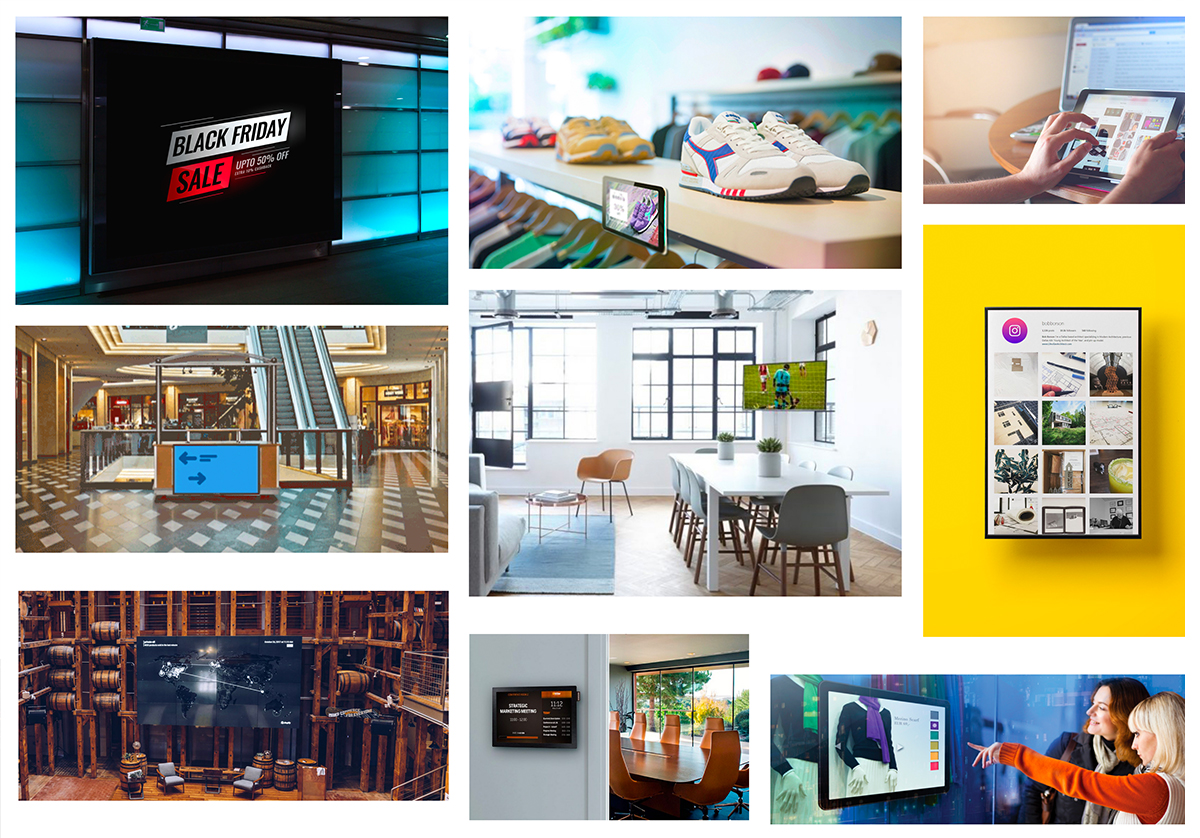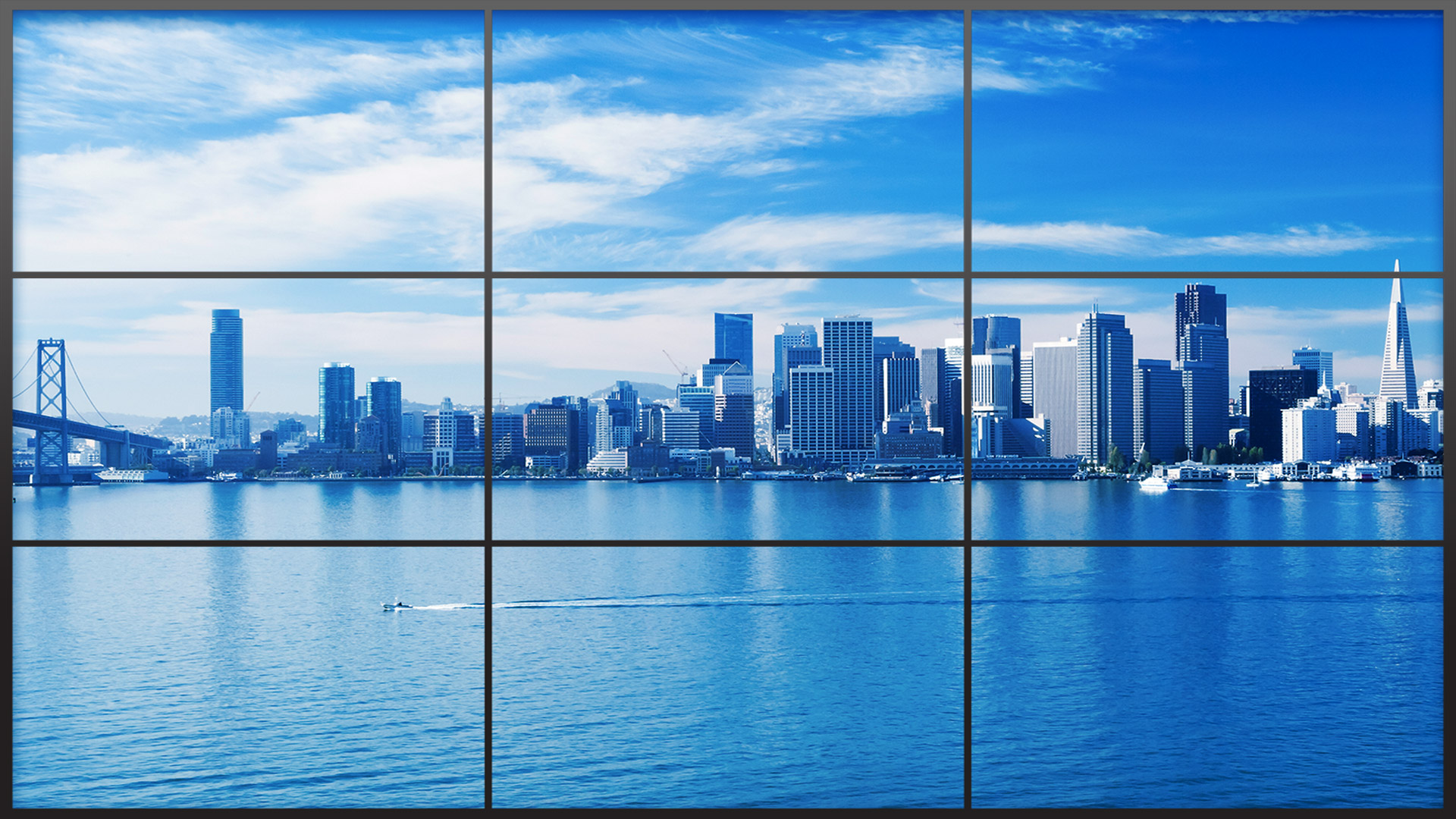What are digital signage displays?
A digital signage display is a screen that’s used to show information and media to a targeted audience. There’s a variety of types, sizes and sophistication available to fit the purpose of any digital signage solution. Unlike consumer TVs, they have been specifically built for the demands of commercial use.

Digital Signage Displays Vs Consumer TVs
Why is it better to use a digital signage display over a consumer TV?
Digital signage displays have been specially built for the heavy demand that commercial use requires. Every year the displays become more powerful, durable, thinner, lighter, versatile and energy efficient. Digital signage displays optimise the impact of your content through their greater performance.
The Advantages of Digital Signage Displays
Screen Brightness
Lifespan
Functionality
Aesthetics
Warranty
System on Chip
Screen Brightness
Why are consumer TV screens not bright enough to be used as digital signage?
Thanks to its higher luminosity, digital signage displays have a brighter, clearer picture, which your digital signage needs in order to be eye catching and captivating. The light output/luminosity of a consumer TV is generally only around 200-300 nits, while digital signage displays can have 1,000 nits or more. To understand the importance of this, we’ll use an example.
A nit measures the amount of light spread over a square meter. If you took the light from the flame of a standard candle and then spread it evenly over a square meter, that’s 1 nit. Add the light of a thousand more candles and spread it over that square meter, and now you’ve got the light output of a digital signage display.
By having four or more times as many nits, a digital signage display has the capacity to output more light and create a brighter, more bold display. With greater brightness comes greater detail and contrast: your images, graphics and videos can all be displayed with every detail visible to your audience.
Additionally, lots of digital signage displays are outside, which puts a screen against its greatest enemy: the sun. The intense light output of a digital signage display allows it to fight back and remain clearly visible even under the harshest conditions. We’ll come back to this later.

Lifespan
How do digital signage displays end up being cheaper than consumer TVs?
Because digital signage displays have been built with long operating hours and longevity in mind, investing in one will keep long-term costs to a minimum compared to a consumer TV. The average consumer TV is built to last 15 months on 12 hours a day, but a digital signage display will last 3 years even if it’s used 24 hours a day every day.
LCD/LED displays can now have a lifetime of up to 100,000 hours before they begin to lose image and colour quality. They contain additional technology – namely, black mura prevention and PID masks – to avoid the darkening and image sticking that occurs with consumer TVs.
Additionally, electrics get hot with overuse. Digital signage displays have a specially built airflow and cooling system that will keep them cool and functioning properly despite long operating hours.
A consumer TV is a cheaper initial investment, but will not survive the long operating hours demanded of them. You’ll end up spending more on electricity, getting them repaired, replacing them every year or so and lose revenue due to downtime whilst they are replaced. Evidently, the ROI is higher with a digital signage display – without even factoring in a digital signage display’s superior visual performance and the greater results as a result of it.

Functionality
Why is the functional capability of a consumer TV too limited for digital signage?
Compared to a consumer TV, digital signage displays have:
- Wider viewing angles
- More size options
- Thinner panels
- Touch screen
- Portrait mode
- Many come with a built-in media player (System On Chip)
- Video wall options (no bezel)
Digital signage displays have portrait mode, unlike consumer TVs. Their design makes this easy to implement as well, as they have thinner panels, are lighter and have better mounting structures.
LDC/LED digital signage displays are available in sizes smaller than any consumer TV, creating the opportunity to use it – or a tablet -on a small surface or shelf with information about the product next to it.On the other side of the spectrum isthe ability to make a video wall, which can be done by combining multiple digital signage displays and will make an emotional connection with your customers.
Consumer TVs are designed to be viewed from straight on, as is the norm in a home. But digital signage displays are built for all sorts of environments, so their screens remain clear from much wider angles.
Giving your audience the opportunity to engage with your displays takes their experience with them to the next level. A touchscreen will allow them to find out more information of their choice, play games, scroll and much more. All of this personalises the interaction.

Aesthetics
Is a digital signage display built to be more physically attractive than a consumer TV?
Here’s how digital signage displays are the more attractive option:
- The cables of the displays can be neatly concealed
- Ultra-thin bezels
- No external buttons on the bezel
- No manufacturer’s logo on the bezel

Warranty
What if something goes wrong with your display and it breaks down?
When a digital signage display is purchased, its warranty will cover a longer period of time, is more extensive and, very importantly, it will covers commercial use. Commercial use, as outlined, puts different demands on a screen, which consumer TVs are not built to manage and so aren’t covered for. Samsung, Philips, LEC and other manufacturers offer multi-year warranties on displays that are used 24 hours a day, guaranteeing your screen will remain perfect. If you use a consumer TV for digital signage purposes, your TVs warranty will not cover it.
System on Chip (SoC)
Is it necessary to have an external media player for digital signage?
Some digital signage displays come with a built-in media player, which is called ‘system on chip’.
This is more time- and cost-effective than buying, installing and connecting a standard TV to an external media player. A clear bonus of system on chip is that the media player does not need an internet connection to connect to the display.
As there’s no external media player or other video distribution equipment, there is less hardware to support and less potential failure points. This saves money, man-hours and downtime. Additionally, it removes the need for messy wires, reduces power consumption and reduces the complexity of resolving future issues, as the hardware within system on chip will be standardized.
Not all digital signage displays have SoC because there are also drawbacks to using it over an external media player. Click here to find out more about the benefits of external media players, or read our extensive guide on media players here.

The Size Options of Digital Signage
How big or small can your digital signage display be?
Tablets & Digital Signage
How can tablets be used as digital signage?
Tablets are cheap, a display and media player in one, portable and versatile. They can easily be mounted, built-into or placed on almost any surface without being obstructive, for example at tills, kiosks, product shelves, public transport, doors and more. This creates new digital opportunities that the larger interactive displays can’t achieve. Their common applications are for small reach but high impact, including:
Giving access to online stores and websites for browsing and purchasing
Allow customers to check themselves into hotels and book tickets whilst browsing their optionsShowing a product’s stock inventory, reviews, comparisons, videos of it in-action and virtual trials on the shelf
On a door to show a meeting or conference room’s availability and for booking
Create an interactive menu at restaurants with the most up-to-date prices and food options, in-depth browsing of ingredients and videos, and the option to make an order
Interactive Displays & Digital Signage
What’s the best way to use interactive displays as digital signage?
An interactive display is a large touch-screen display. A person’s experience with this display is personalised, which creates new digital signage opportunities:
- Interactive digital signage displayDeeper engagement: Strengthen your brand image
- Personalised customer experience: specific information and recommendations
- Long dwell time: Customers have the time to engage
- Customer analytics: Live data feedback
Touch screen displays deliver each customer a unique experience. Customers can go beyond looping playlists by interacting with displays to see what’s most relevant and important to them. This level of personalization creates a well-informed customer that will be more confident in buying and becoming loyal. Modern customers expect consistent experiences across digital and physical brand experiences and interactive digital signage gives in-store customers the convenience of online shopping.
However, interactive displays are frequently great in theory but hard to implement. Audiences can find them hard to use, the screens get dirty very quickly so must be cleaned frequently and only one person can use them at a time.
How interactive digital signage can help your business:
- Customers will be getting more information when they are at peak interest
Buttons and calls to action can guide customers through their purchasing journey - Give customers the confidence to learn more about your brand, explore your event or discover your products
- Create new forms of payment: mobile payments such as Android Pay, Apple Pay, Google Wallet, and Samsung Pay can be supported
- Enable and encourage e-commerce purchasing while in-store
- Reduces staff interruptions by answering questions
- Staff can share information, data and content in real-time to each other from multiple devices and locations to make collaborations more effective
- Staff can book meeting or conference rooms on-the-spot or check for future availability
How interactive digital signage displays can help your customer:
- Multi-language support
- Built-in touch screen keyboard for quick and easy searching
- Pinch and zoom on media
- FAQ section
- Creates faster and simpler service
- Maps and directions for effective wayfinding
LCD/LED Displays
These types of displays are the standard for digital signage, so no matter what the information or entertainment is that you are wanting to communicate, there will be an LCD/LED display to do it effectively. They are not interactive, but are available in a wide range of sizes, resolutions, brightness and even different shapes (extra wide ‘stretch’ screens are available).
What’s the difference between an LED and LCD display?
The difference between LCD and LED displays is minimal, as they are using very similar technology. They are actually both liquid crystal displays, but LEDs use light-emitting diodes instead of fluorescent ones. This slight technological difference means that LED displays are able to be slightly thinner, they are more energy efficient and generally have a superior display quality with sharper colours and deeper black. LCD displays are now being phased out, as LED is seen to be the future of digital signage.

Videowalls
What’s the best type of digital signage to grab attention?
As LED displays have become commonplace, video walls are becoming popular to stand out – as an exemplar, think of Times Square. Video walls are made by placing a series of displays next to each other and connecting them to create one whole display. This creates opportunities to show content on a screen many times larger than on an LED display and therefore to an audience far greater than a LED display can achieve. You can create a large video in the form of a wall, flower or windmill and emphasise your audiovisual message. However, it’s important that you don’t try to show a low resolution image on a high definition large video wall, as the image will appear blurry and ineffective.

- Shopping malls advertise brands and for wayfinding
- Airports display a live data feed of flight information
- Financial institutions display live feeds of the stock exchange
- Entertainment uses them to transform environments with dynamic videos
- Live events use them for wayfinding, updates and live camera feeds
- Hotels put them in their lobbies to show mood-setting images and videos Generally used to create immersive experiences and augmented reality
The Size Options of Digital Signage
How big or small can your digital signage display be?
When you’re deciding the size of a digital signage display, you’ll need to think about a few factors:
● What is the average viewing distance of your audience going to be?
● What type of media are you going to show?
● Are you going to use a split screen format?
The further your audience is going to be from the display, the bigger you’ll need your content to be in order to keep it not only eye catching but also understandable. It’s a rare moment that someone gets enticed by a display they can’t see properly. From buttons and writing to logos and graphics, size matters. The size of each object will depend on the display’s size and resolution.
This leads onto the type of content. You need to ensure content features aren’t drowned out or too overwhelming. If your display is going to be showing a lot of text-based content, then your screen will need to be bigger to keep it readable. It is recommended that you have your writing 1” tall for every 10 feet you expect it to be read from. Or maybe your using your display as an advertising space? Your potential advertisers won’t be keen to advertise on a small screen with a low reach. If your screen is going to be split between different content at the same time, it’s likely you’ll need a bigger display to ensure all content remains big enough to be seen properly.
What are the size options for each type of digital signage?
● Tablets: 10” to 21”
● LCD/LED Displays: 22” to 98”
● Interactive Displays: 43” to 98”
● Video Walls: 49’ to 55”
Indoor vs Outdoor Digital Signage Displays
What's the difference between an indoor and outdoor display?
Brightness
Weather Protection
Connectivity
Security
Brightness
Why are outdoor digital displays brighter than indoor?
In order to fight back against bright sunlight a display must be 700 nits (measurement of light output) or more, so an outdoor display can have up to 10,000 nits and does so whilst consuming as little energy as possible.
This means that it can maintain a clear screen visibility and does so in a cost-efficient manner. To prevent wasted energy and irritation to eyes, many outdoor screens will have an ambient light sensor to match its brightness to the outside environment.
Weather Protection
How are outdoor displays protected from tough weather?
Outdoor displays have IP rated enclosures (minimum IP65) to keep the display sealed away from dust and the effects of rain, snow and humidity. The annealed glass used for outdoor displays is four times stronger than what’s used for indoor digital signage. This makes it more resilient to shattering and general wear.
They also have a cooling system to keep the temperature within the seal regulated, preventing damage from hot environments and the heat emitted by the screen itself. The core panels are also made resilient to heat variations, as any fluctuations would weaken the components and create moisture.
Connectivity
Can outdoor displays connect to the internet?
To connect an indoor display to the internet is simple, as they can usually be connected wirelessly to the Wi-Fi or with an ethernet cable. However, outdoor displays may be just out of reach or spread across locations. In order to maintain live updates and remote control, outdoor digital signage usually has built-in hardware that enables it to connect to a cellular network.
Security
Does an outdoor display have extra security?
As comes with the nature of outdoor and public environments, there are additional security concerns for outdoor displays compared to indoor digital signage. Outdoor displays will have built-in security precautions and safeguards to protect it against hackers. This prevents company data from being stolen and displays from showing unwanted, potentially offensive content.
Digital Signage Display Manufacturers
Who are the best digital signage display manufacturers?
The biggest brands in the digital signage display market 2018:
- 1. Samsung: 300,000 units and 33% market share
- 2. LG: 75,000 units and 8.5% market share
- 3. Goodview: 70,000 units and 8% market share
- 4. NEC: 65,000 units and 7.4%
Samsung has remained dominant in the digital signage display market for many years now and continues to increase its market share. Its closest competitors are LG and Goodview, but LG’s market share actually reduced by 2.3% in 2018. Goodview has the greatest market share in China and grew its overall market share by 0.9% with a 30% increase in sales, suggesting it will become Samsung’s biggest competition soon. NEC was replaced by Goodview for third place in 2018 because Goodview had such a strong year, but also because NEC had a 5.4% drop in sales.
IAdea is an up-and-coming manufacturer, especially for its smaller displays. It has even partnered with Samsung to make its displays compatible with Samsung’s Tizen operating system.
Samsung is the greatest manufacturer of digital signage displays and doesn’t look likely to lose this accolade any time soon. As this data shows, digital signage displays is a highly competitive market with the biggest players fighting for market share in what is a rapidly growing market. This is great for businesses like yours, as it means there’s lots of options to choose from, prices are kept low and the brands are forced to be innovative to survive.

OLED Displays
Are OLED displays the digital signage of today or the future?
OLED (organic light-emitting diode) commercial displays are now on the market. These displays are even thinner and lighter than LCD displays, as they don’t require a backlight, and are able to produce absolute black. This creates a darker display with a greater contrast ratio, which gives it clear visibility in bright sunlight. Not only that, but it can also be dual-view, thanks to its transparency. It’ll allow you to show your content on both sides, creating even more digital signage opportunities.
OLED is available today and will only continue to grow in use as the technology improves. There’s no such thing as a budget OLED display, so this technology will come at a heavy price compared to a LED display.
